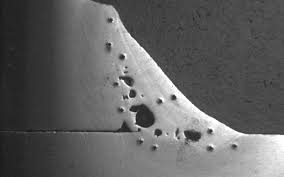Professional Guidance on What is Porosity in Welding and How to Resolve It
Professional Guidance on What is Porosity in Welding and How to Resolve It
Blog Article
The Science Behind Porosity: A Comprehensive Overview for Welders and Fabricators
Understanding the intricate mechanisms behind porosity in welding is essential for welders and makers pursuing flawless workmanship. As metalworkers dive right into the depths of this phenomenon, they uncover a world governed by different elements that influence the development of these tiny spaces within welds. From the make-up of the base materials to the intricacies of the welding process itself, a wide variety of variables conspire to either exacerbate or minimize the existence of porosity. In this detailed overview, we will unwind the science behind porosity, discovering its results on weld high quality and unveiling advanced techniques for its control. Join us on this journey via the microcosm of welding imperfections, where precision fulfills understanding in the search of perfect welds.
Understanding Porosity in Welding
FIRST SENTENCE:
Assessment of porosity in welding exposes essential insights right into the stability and high quality of the weld joint. Porosity, identified by the visibility of dental caries or spaces within the weld steel, is an usual worry in welding procedures. These voids, if not appropriately dealt with, can endanger the structural honesty and mechanical residential properties of the weld, leading to possible failures in the ended up product.

To discover and quantify porosity, non-destructive screening methods such as ultrasonic testing or X-ray evaluation are commonly employed. These techniques enable the recognition of internal issues without jeopardizing the honesty of the weld. By evaluating the size, shape, and circulation of porosity within a weld, welders can make enlightened decisions to boost their welding procedures and accomplish sounder weld joints.

Aspects Influencing Porosity Formation
The incident of porosity in welding is affected by a myriad of elements, ranging from gas protecting performance to the details of welding criterion settings. Welding parameters, consisting of next voltage, current, take a trip speed, and electrode type, likewise effect porosity formation. The welding technique utilized, such as gas metal arc welding (GMAW) or shielded metal arc welding (SMAW), can influence porosity development due to variants in warm distribution and gas protection - What is Porosity.
Impacts of Porosity on Weld Top Quality
The visibility of porosity additionally compromises the weld's resistance to deterioration, as the trapped air or gases within the gaps can respond with the surrounding setting, try this website leading to destruction over time. In addition, porosity can hinder the weld's capability to withstand stress or impact, more endangering the general high quality and integrity of the bonded framework. In essential applications such as aerospace, vehicle, or architectural building and constructions, where safety and longevity are extremely important, the detrimental impacts of porosity on weld high quality can have severe repercussions, highlighting the value of decreasing porosity through proper welding methods and treatments.
Strategies to Minimize Porosity
Furthermore, using the suitable welding criteria, such as the proper voltage, current, and travel rate, is essential in protecting against porosity. Keeping a regular arc size and angle throughout welding likewise helps reduce the probability of porosity.

In addition, choosing the ideal protecting gas and keeping appropriate gas circulation rates are necessary in lessening porosity. Making use of the suitable welding technique, such as back-stepping or employing a weaving activity, can also aid distribute heat equally and decrease the chances of her comment is here porosity development. Finally, making certain appropriate ventilation in the welding atmosphere to remove any type of possible resources of contamination is vital for attaining porosity-free welds. By executing these methods, welders can effectively reduce porosity and produce top notch bonded joints.

Advanced Solutions for Porosity Control
Executing sophisticated modern technologies and cutting-edge approaches plays a pivotal role in accomplishing remarkable control over porosity in welding processes. Additionally, utilizing innovative welding methods such as pulsed MIG welding or modified environment welding can likewise aid alleviate porosity concerns.
An additional sophisticated option involves the usage of advanced welding tools. Making use of equipment with integrated attributes like waveform control and advanced power resources can boost weld quality and reduce porosity dangers. The application of automated welding systems with precise control over specifications can considerably lessen porosity flaws.
Furthermore, including innovative surveillance and evaluation innovations such as real-time X-ray imaging or automated ultrasonic screening can assist in discovering porosity early in the welding procedure, enabling prompt corrective activities. In general, incorporating these innovative services can greatly enhance porosity control and boost the total top quality of welded parts.
Verdict
Finally, recognizing the science behind porosity in welding is important for welders and makers to create top quality welds. By determining the elements influencing porosity development and carrying out methods to minimize it, welders can boost the general weld top quality. Advanced solutions for porosity control can better improve the welding process and ensure a strong and reliable weld. It is necessary for welders to continually inform themselves on porosity and apply best techniques to attain optimal outcomes.
Report this page